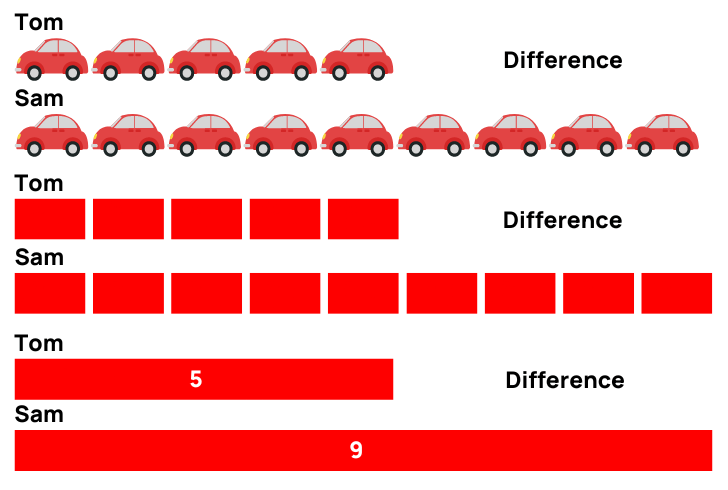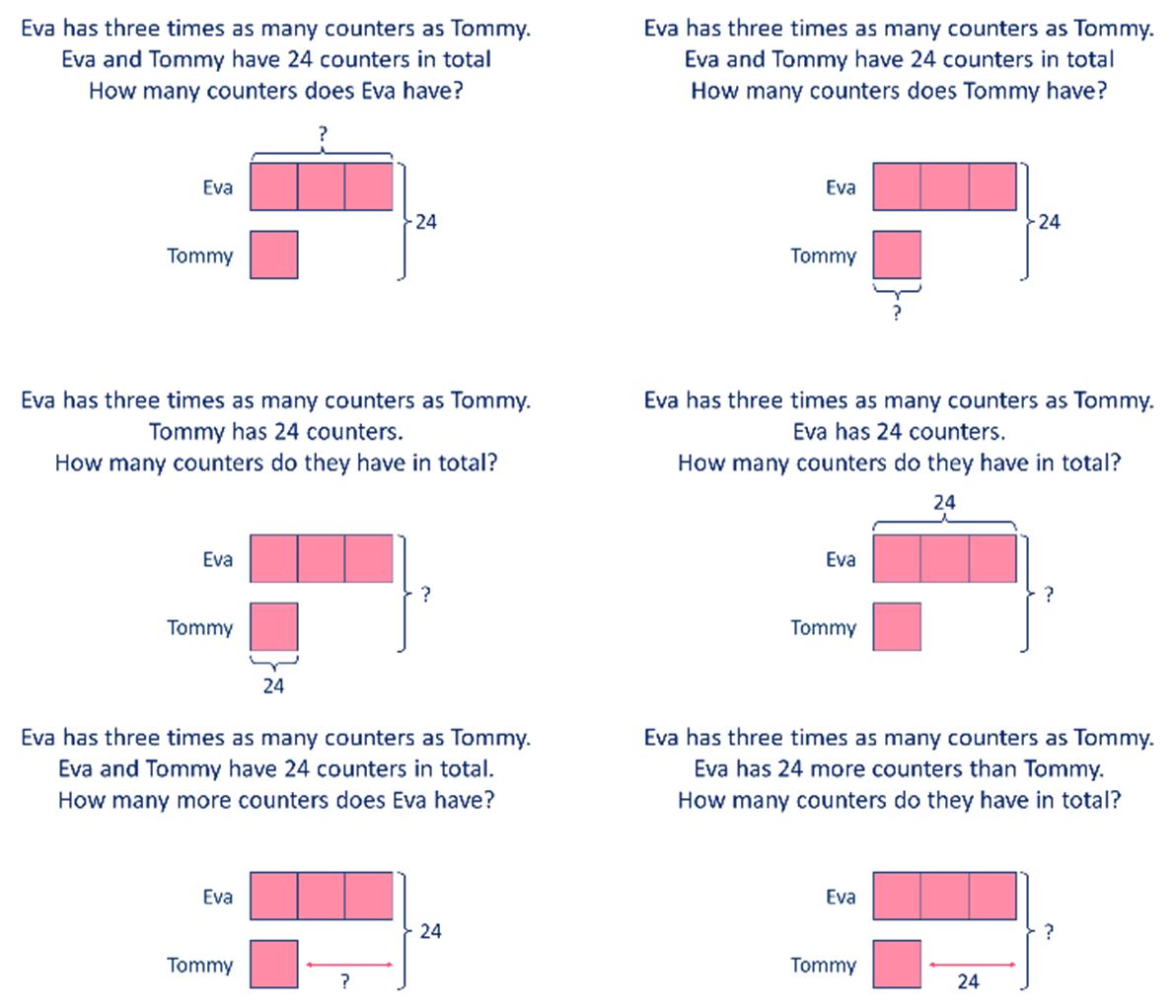Boost analytical skills with consistent practice of bar model drawing techniques
Wiki Article
Exploring Bar Version Drawing Techniques: A Comprehensive Overview to Envisioning Mathematics Concepts
Bar version drawing strategies work as a beneficial source for both educators and students in envisioning mathematical concepts. These designs simplify complex numerical partnerships, aiding in the comprehension of enhancement, reproduction, reduction, and division. This overview outlines efficient strategies for implementing bar versions, promoting active involvement and real-world links. As readers explore the useful applications and mentor pointers, they will discover how these techniques can change their strategy to maths.Understanding the Basics of Bar Version Illustration
Bar model attracting functions as an effective aesthetic tool in mathematics, promoting the understanding of problem-solving methods and mathematical relationships. This technique involves standing for numbers and their relationships with rectangle-shaped bars, making it much easier to imagine procedures such as addition, reduction, multiplication, and division. Each bar's length represents a particular value, enabling learners to compare amounts and understand percentages clearly.To develop a bar model, one begins by recognizing the trouble's crucial aspects, usually simplifying into parts that can be visually represented. As an example, in an easy addition trouble, 2 bars can be drawn, with their lengths representing the addends. The mixed size illustrates the amount. Furthermore, bar designs can be adapted for much more complicated problems, consisting of fractions and proportions, by changing the bars appropriately. Mastering these essentials lays a strong foundation for efficient problem-solving and much deeper mathematical understanding.
Benefits of Making Use Of Bar Models in Math
Using bar models in mathematics supplies many advantages that improve knowing and understanding. These visual depictions aid trainees in comprehending intricate principles by breaking them down right into convenient components. Bar versions provide a clear framework for illustrating relationships in between numbers, making abstract concepts much more concrete. They advertise a much deeper understanding of mathematical operations and promote problem-solving by permitting learners to envision the data they are dealing with.Bar designs support the growth of critical thinking skills, as students should examine and translate the visual details to attract verdicts. This approach urges active engagement with the material, reinforcing retention and proficiency of mathematical concepts. By cultivating a solid structure in aesthetic proficiency, bar models encourage students to come close to different mathematical obstacles with self-confidence. On the whole, the combination of bar versions right into mathematics education proves valuable in growing both understanding and logical capabilities among students.
Using Bar Designs to Addition and Subtraction
Bar designs work as an efficient tool for aesthetically representing addition and subtraction troubles. By showing the connection between numbers, they boost understanding and assist in analytical. On top of that, real-life applications of these models can aid students understand mathematical ideas in useful contexts.Representing Enhancement Aesthetically
Aesthetic help can substantially boost their understanding of these procedures when pupils experience enhancement and reduction problems. Bar designs serve as effective tools for representing addition. By separating a rectangle right into sections that correspond to the numbers included, pupils can visualize the relationship in between the quantities. If a trainee requires to add 3 and 5, they can develop a bar split right into two areas: one area representing 3 and the various other standing for 5. This clear representation not just streamlines the addition procedure but likewise reinforces the idea of incorporating quantities. As trainees adjust these aesthetic aids, they create a deeper comprehension of addition, bring about improved analytical abilities and better confidence in their mathematical capabilities.
Reduction With Bar Versions
Although subtraction is typically viewed as an extra intricate operation than enhancement, bar models can successfully clarify this procedure for students. By visually representing the quantities involved, trainees can much better understand just how numbers associate with each other. In a bar design for subtraction, one bar represents the total, while another suggests the quantity being subtracted. This visual distinction helps students grasp the principle of "eliminating." As an example, if a bar shows 10 units, and one more bar representing 4 units is removed, pupils can quickly see that 6 devices stay. This technique not just fosters understanding of reduction yet additionally aids in developing problem-solving abilities, permitting trainees to imagine their mathematical reasoning and boost their general comprehension of mathematical ideas.Real-Life Application Examples
Recognizing reduction through bar models lays a structure for applying these techniques in real-life circumstances. In numerous contexts, such as budgeting or buying, individuals can picture just how much money continues to be after costs. For instance, if an individual has $50 and spends $20, a bar version can represent the complete amount and the invested part, illustrating that $30 is left. Furthermore, moms and dads can use bar versions to aid kids understand the number of even more products require to be contributed to complete a set, such as having three apples and needing five. This graph streamlines intricate issues, helping with understanding and retention. Ultimately, bar designs function as efficient devices in everyday decision-making, enhancing mathematical understanding in sensible situations.Envisioning Multiplication and Department With Bar Versions
In exploring the application of bar designs for reproduction and department, it is necessary to realize their fundamental concepts. Building multiplication versions allows learners to picture partnerships between numbers, while reliable department strategies can be shown with these visual help. This technique boosts comprehension and analytic skills in maths.Understanding Bar Models
Bar models act as an effective aesthetic device for illustrating the principles of reproduction and department. They allow students to represent mathematical partnerships in an organized style, promoting a deeper understanding of these operations. In reproduction, bar models display teams of equal size, permitting people to envision the overall quantity when incorporating these teams. Alternatively, in department, bar versions aid illustrate exactly how a total amount is separated right into smaller, equal parts, making clear the principle of dividing. By employing these visual aids, pupils can understand the underlying principles of multiplication and department better. This method not only boosts understanding but likewise sustains analytical skills, making bar models a vital possession in mathematical education and learning.Building Reproduction Versions
Constructing multiplication models using bar representations uses a clear method for imagining the procedure of reproduction. These designs enable students to represent multiplication as teams of equal components, making abstract ideas a lot more concrete. To illustrate (3 times 4), a pupil can draw one bar separated into 3 equivalent segments, each standing for 4 devices. In addition, developing a 2nd bar with the same length enhances the understanding of repeated addition, as each segment corresponds to one team. This visual representation not only aids in comprehending multiplication however additionally improves analytical skills. By using bar designs, trainees can better comprehend partnerships between numbers and establish a robust foundation for a lot more complex mathematical principles, causing raised confidence in their capabilities.Visualizing Division Methods

Fixing Word Troubles Making Use Of Bar Design Techniques

As an example, in an issue including addition and reduction, students can attract separate bars for every quantity and afterwards control them to find the solution. This procedure not only clarifies the issue however also fosters a much deeper conceptual understanding. Bar designs can be adapted for various kinds of word problems, making them flexible across different mathematical subjects. Eventually, utilizing bar models can significantly boost trainees' problem-solving abilities by offering a clear aesthetic pathway to get to the proper response.
Integrating Bar Versions in Different Mathematics Topics
Bar designs can be effortlessly integrated into different math subjects, enhancing trainees' understanding of concepts beyond standard math. In algebra, these aesthetic tools help in representing formulas and inequalities, allowing students to visualize connections between variables. When taking on geometry, bar designs can illustrate the properties of forms and spatial reasoning, aiding trainees grasp ideas like location and perimeter successfully. In data, bar designs help with the analysis of information collections, allowing students to compare quantities and acknowledge fads visually. Furthermore, incorporating bar versions within measurement subjects help in understanding devices and conversions by providing a substantial representation of quantities. By utilizing bar designs throughout different mathematical areas, educators can promote a deeper understanding of complex concepts, thus enhancing analytic skills and promoting essential reasoning (bar model drawing techniques). This flexibility demonstrates the utility of bar designs as a foundational tool for trainees in their mathematical journeyTips for Mentor Bar Designs Successfully
Integrating bar designs right into mentor find this methods requires thoughtful techniques to maximize their efficiency. Educators ought to begin by presenting bar versions with straightforward, relatable instances that pupils can quickly comprehend. This assists to develop self-confidence and familiarity with the principle. Progressively boosting the intricacy of problems allows students to apply their skills gradually. Additionally, educators need to encourage trainees to create their very own bar designs, advertising energetic involvement and ownership of their knowing.Incorporating collaborative activities can also boost understanding, as trainees review and address problems in teams. Constant feedback is important; instructors must give constructive commentary on pupils' bar design representations to guide renovation. Attaching bar designs to real-life situations reinforces their relevance, assisting students see the functional applications of their mathematical abilities. By carrying out these approaches, educators can efficiently harness the power of bar versions in their mathematics direction.
Often Asked Questions
Can Prevent Versions Be Utilized in Other Subjects Besides Mathematics?
Bar models can undoubtedly be used in various subjects beyond mathematics. They properly highlight concepts in science, social researches, and language arts, aiding to aesthetically stand for relationships, processes, and concepts for enhanced understanding across techniques.What Age Is Best Matched for Knowing Bar Designs?
Bar designs are best matched for kids ages 7 to 12, as they create concrete reasoning abilities throughout this period (bar model drawing techniques). At this age, trainees can effectively comprehend abstract principles with aesthetic depiction and problem-solving strategiesExist Digital Tools for Creating Bar Models?

Exactly How Can I Analyze Trainee Recognizing of Bar Designs?
Evaluating pupil understanding of bar designs can involve tests, observational assessments, and seminar. Educators may also analyze trainees' completed designs and their ability to clarify their reasoning, making certain a complete assessment of understanding.Source
What Prevail Blunders When Utilizing Bar Versions?
Typical blunders when using informative post bar versions include misrepresenting quantities, stopping working to accurately identify bars, perplexing addition and subtraction, neglecting to utilize regular scales, and neglecting the importance of clear aesthetic splitting up between different aspects.In enhancement, bar models can be adapted for a lot more intricate problems, consisting of fractions and proportions, by changing the bars accordingly. Subtraction is frequently regarded as a more complicated operation than enhancement, bar models can efficiently clarify this procedure for students. In a bar model for reduction, one bar represents the overall, while an additional indicates the quantity being subtracted. If a bar reveals 10 units, and another bar representing 4 systems is gotten rid of, students can easily see that 6 units remain. When splitting an overall right into equivalent teams, pupils can attract a long bar to represent the whole and then segment it into smaller sized bars that suggest each team.
Report this wiki page